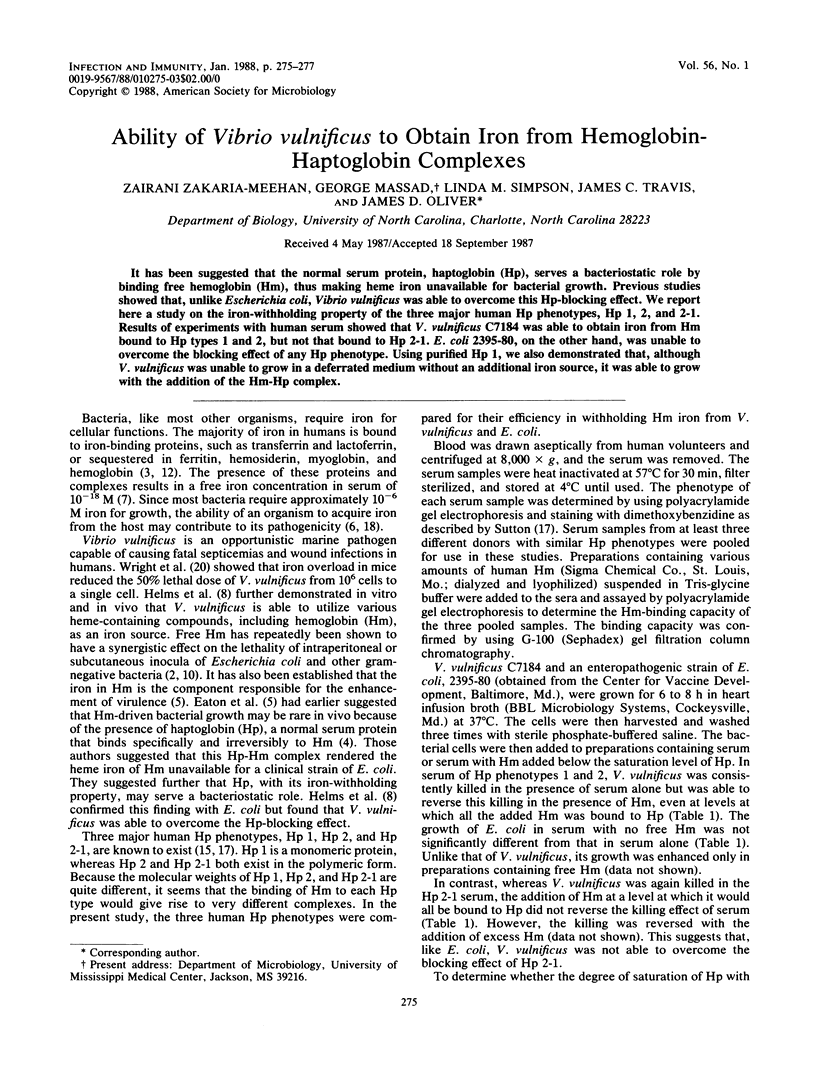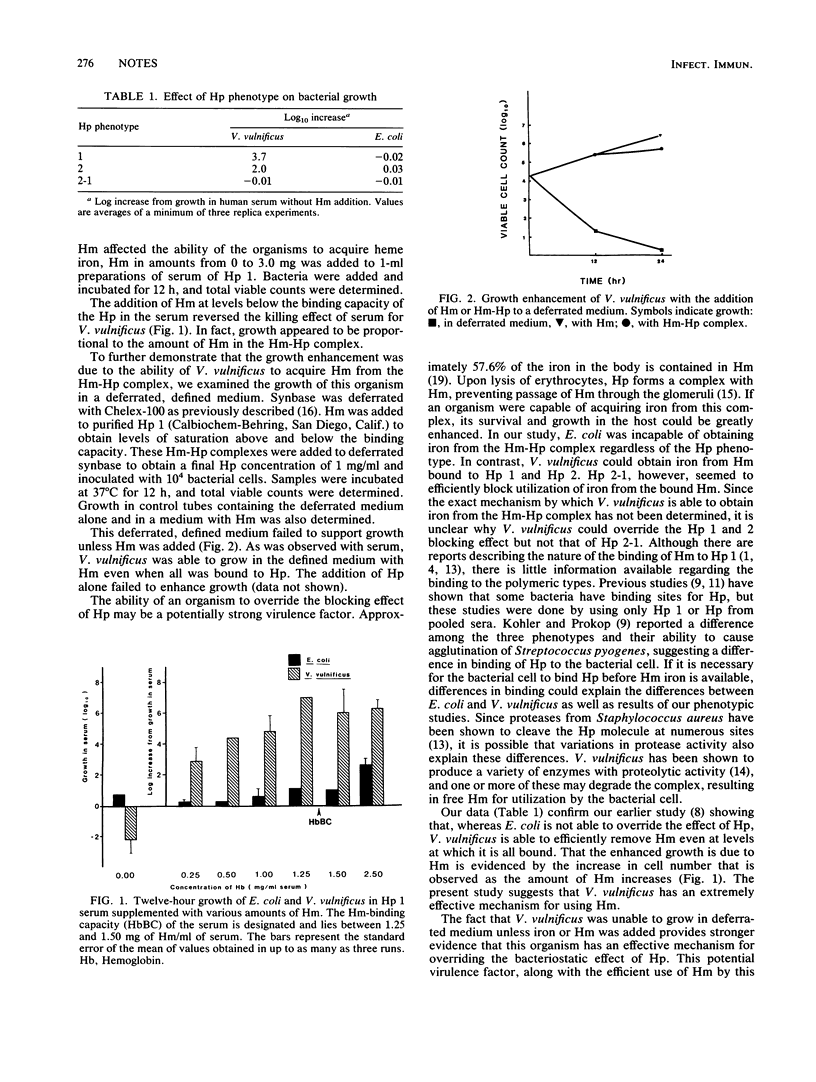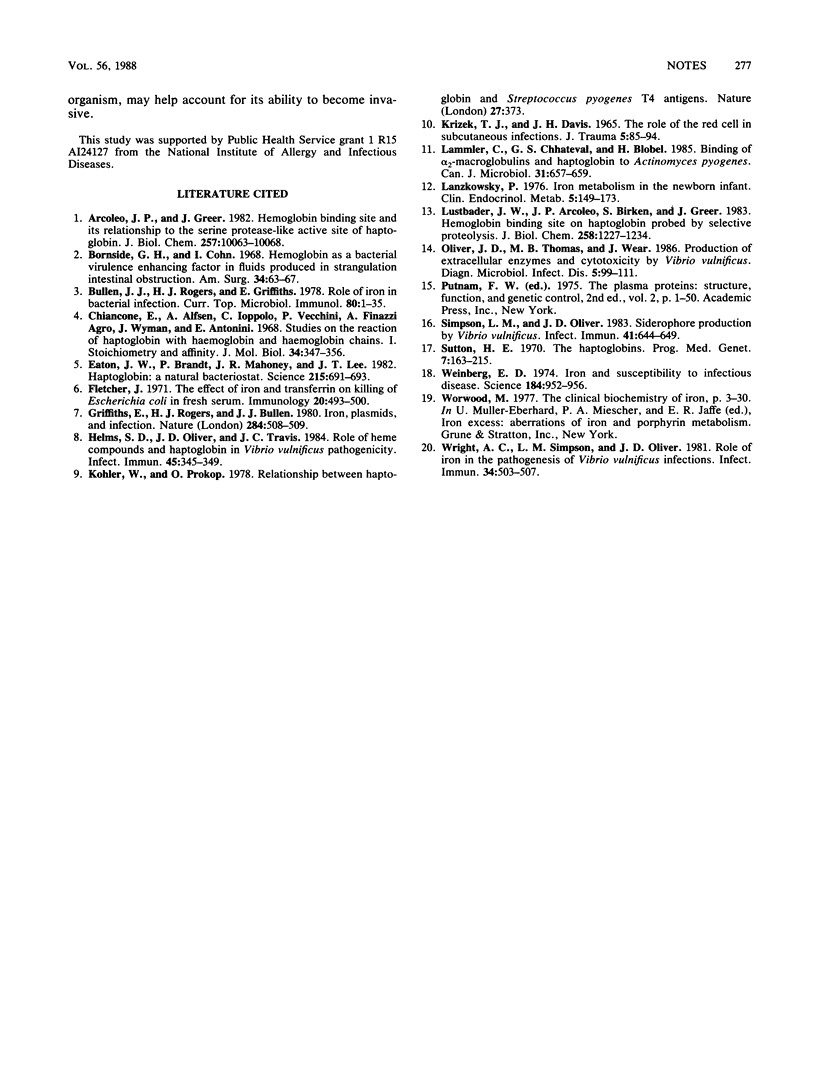Abstract
It has been suggested that the normal serum protein, haptoglobin (Hp), serves a bacteriostatic role by binding free hemoglobin (Hm), thus making heme iron unavailable for bacterial growth. Previous studies showed that, unlike Escherichia coli, Vibrio vulnificus was able to overcome this Hp-blocking effect. We report here a study on the iron-withholding property of the three major human Hp phenotypes, Hp 1, 2, and 2-1. Results of experiments with human serum showed that V. vulnificus C7184 was able to obtain iron from Hm bound to Hp types 1 and 2, but not that bound to Hp 2-1. E. coli 2395-80, on the other hand, was unable to overcome the blocking effect of any Hp phenotype. Using purified Hp 1, we also demonstrated that, although V. vulnificus was unable to grow in a deferrated medium without an additional iron source, it was able to grow with the addition of the Hm-Hp complex.
Full text
PDF


Selected References
These references are in PubMed. This may not be the complete list of references from this article.
- Arcoleo J. P., Greer J. Hemoglobin binding site and its relationship to the serine protease-like active site of haptoglobin. J Biol Chem. 1982 Sep 10;257(17):10063–10068. [PubMed] [Google Scholar]
- Bornside G. H., Cohn I., Jr Hemoglobin as a bacterial virulence-enhancing factor in fluids produced in strangulation intestinal obstruction. Am Surg. 1968 Jan;34(1):63–67. [PubMed] [Google Scholar]
- Bullen J. J., Rogers H. J., Griffiths E. Role of iron in bacterial infection. Curr Top Microbiol Immunol. 1978;80:1–35. doi: 10.1007/978-3-642-66956-9_1. [DOI] [PubMed] [Google Scholar]
- Chiancone E., Alfsen A., Ioppolo C., Vecchini P., Agrò A. F., Wyman J., Antonini E. Studies on the reaction of haptoglobin with haemoglobin and haemoglobin chains. I. Stoichiometry and affinity. J Mol Biol. 1968 Jul 14;34(2):347–356. doi: 10.1016/0022-2836(68)90258-1. [DOI] [PubMed] [Google Scholar]
- Eaton J. W., Brandt P., Mahoney J. R., Lee J. T., Jr Haptoglobin: a natural bacteriostat. Science. 1982 Feb 5;215(4533):691–693. doi: 10.1126/science.7036344. [DOI] [PubMed] [Google Scholar]
- Fletcher J. The effect of iron and transferrin on the killing of Escherichia coli in fresh serum. Immunology. 1971 Apr;20(4):493–500. [PMC free article] [PubMed] [Google Scholar]
- Griffiths E., Rogers H. J., Bullen J. J. Iron, plasmids and infection. Nature. 1980 Apr 10;284(5756):508–509. doi: 10.1038/284508a0. [DOI] [PubMed] [Google Scholar]
- Helms S. D., Oliver J. D., Travis J. C. Role of heme compounds and haptoglobin in Vibrio vulnificus pathogenicity. Infect Immun. 1984 Aug;45(2):345–349. doi: 10.1128/iai.45.2.345-349.1984. [DOI] [PMC free article] [PubMed] [Google Scholar]
- KRIZEK T. J., DAVIS J. H. THE ROLE OF THE RED CELL IN SUBCUTANEOUS INFECTION. J Trauma. 1965 Jan;5:85–95. doi: 10.1097/00005373-196501000-00009. [DOI] [PubMed] [Google Scholar]
- Köhler W., Prokop O. Relationship between haptoglobin and Streptococcus pyogenes T4 antigens. Nature. 1978 Jan 26;271(5643):373–373. doi: 10.1038/271373a0. [DOI] [PubMed] [Google Scholar]
- Lanzkowsky P. Iron metabolism in the newborn infant. Clin Endocrinol Metab. 1976 Mar;5(1):149–174. doi: 10.1016/s0300-595x(76)80012-6. [DOI] [PubMed] [Google Scholar]
- Lustbader J. W., Arcoleo J. P., Birken S., Greer J. Hemoglobin-binding site on haptoglobin probed by selective proteolysis. J Biol Chem. 1983 Jan 25;258(2):1227–1234. [PubMed] [Google Scholar]
- Lämmler C., Chhatwal G. S., Blobel H. Binding of alpha 2-macroglobulin and haptoglobin to Actinomyces pyogenes. Can J Microbiol. 1985 Jul;31(7):657–659. doi: 10.1139/m85-124. [DOI] [PubMed] [Google Scholar]
- Oliver J. D., Wear J. E., Thomas M. B., Warner M., Linder K. Production of extracellular enzymes and cytotoxicity by Vibrio vulnificus. Diagn Microbiol Infect Dis. 1986 Jul;5(2):99–111. doi: 10.1016/0732-8893(86)90112-4. [DOI] [PubMed] [Google Scholar]
- Simpson L. M., Oliver J. D. Siderophore production by Vibrio vulnificus. Infect Immun. 1983 Aug;41(2):644–649. doi: 10.1128/iai.41.2.644-649.1983. [DOI] [PMC free article] [PubMed] [Google Scholar]
- Sutton H. E. The haptoglobins. Prog Med Genet. 1970;7:163–216. [PubMed] [Google Scholar]
- Weinberg E. D. Iron and susceptibility to infectious disease. Science. 1974 May 31;184(4140):952–956. doi: 10.1126/science.184.4140.952. [DOI] [PubMed] [Google Scholar]
- Worwood M. The clinical biochemistry of iron. Semin Hematol. 1977 Jan;14(1):3–30. [PubMed] [Google Scholar]
- Wright A. C., Simpson L. M., Oliver J. D. Role of iron in the pathogenesis of Vibrio vulnificus infections. Infect Immun. 1981 Nov;34(2):503–507. doi: 10.1128/iai.34.2.503-507.1981. [DOI] [PMC free article] [PubMed] [Google Scholar]


